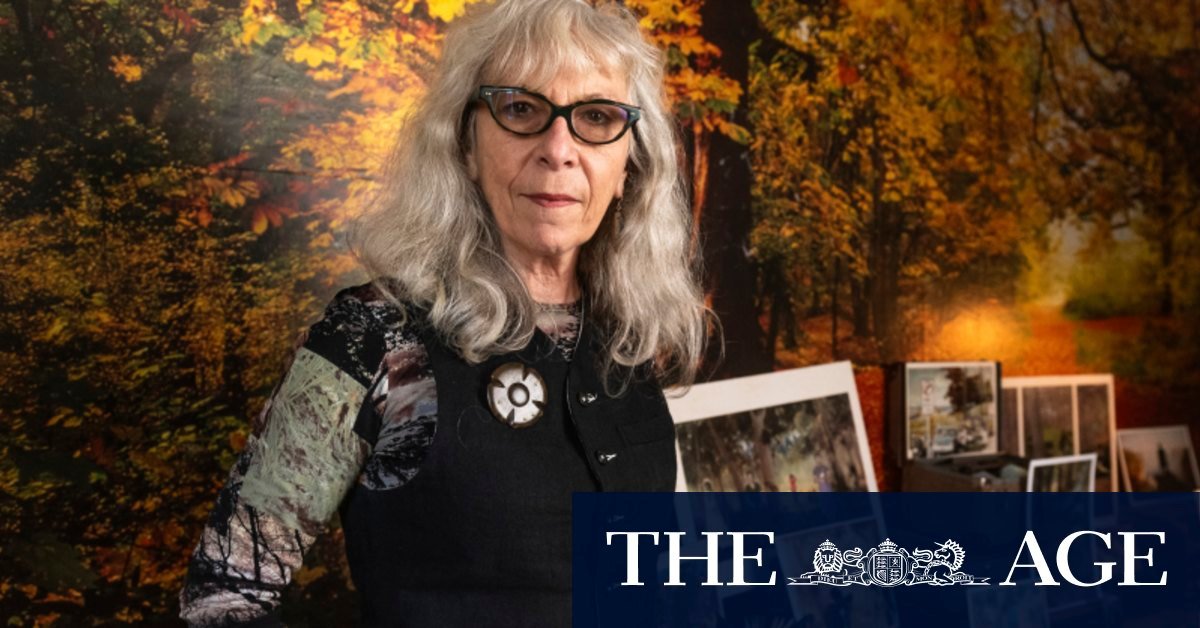Although she was born in Australia, Zahalka never felt like she and her immigrant family fit into the Australian landscape. Her Slavic surname, the legacy of her Czech-born father, always stood out. He migrated to Australia with her Viennese Jewish mother and her older sister in 1950. Her Jewish grandmother had perished in Auschwitz, but growing up on Sydney’s north shore she was christened Catholic with no clue of her Jewish origins.
“I often think about the enormity of my mother losing everything – her family, her possessions and her previous life … perhaps that’s why I’m a collector,” Zahalka says.

Anne Zahalka’s home archive, which is recreated in the NAS exhibition.Credit: Rhett Wyman
At 67, as she prepares for a major survey exhibition at her alma mater, the National Art School (NAS), it is easy to see why one of Australia’s most highly regarded photo-media artists is in a reflective mood. Her work spans more than 40 years and 40 solo shows and is in major international collections. This retrospective assembles more than 100 works from 15 different photographic series, alongside collected ephemera from her studio and archive.
Zahalka had an aunt who was a photographer, and keeps her old Rolleiflex camera in a glass cabinet at home. Educated at Cremorne Girls High, Zahalka went to Seaforth Tech, where she studied photography, and then transferred to East Sydney Tech (now NAS), where artist Cressida Campbell was a contemporary. It was here she started playing with photo collages, long before digital manipulation on computers was possible.
“All of that now you just scan after you find your images off the web, and you use Photoshop with a digital scalpel and airbrush, but then it was the real thing,” says Zahalka.
“I love the magic of watching a photo develop, but I also loved the idea of paintings by the great masters. I found myself being drawn to the art canon and then finding my own visual language to place it in a contemporary setting.”

Anne Zahalka’s On the Wallaby Track – a long way from home, 1983.
Credit: National Art School
She began to reconfigure the hallowed ground of late-19th-century Australian impressionist painters like Tom Roberts and Frederick McCubbin, credited with defining the nation. In one of her earliest bodies of collage, the work On the Wallaby Track – A long way from home (1983), she substitutes an older European migrant woman in black for the original painting’s itinerant Anglo-Saxon mother and Australian-born baby.
“I was interested in these representations of Australian nationalist identity I’d grown up with in school and I started inserting my family story and other migrants into this kind of Australian narrative.”
She started playing with photos of her postwar migrant family snapped by a Sydney street photographer, placing them in Australian pastoral scenes painted by pioneers.

The Immigrants, 1983, a collage of family photographs on a McCubbin reproduction, include Zahalka’s
family photographs of her parents and sister (left panel), her father’s panel beating business in Rushcutters Bay and the artist in a pram with her sister and mother (middle panel), and the Zahalka family grave in what was then known as Czechoslovakia.Credit: National Art School
Other familiar Australian settings for collage were Bondi, where her refugee family first lived when they arrived. It was the backdrop for her series Bondi: Playground of the Pacific, which inserted ethnic rather than Anglo-Saxon faces into beach scenes.
Bondi was also the backdrop for one of her best-known works, The Bathers (1989), which set her auction price record in 2021 when it sold for $27,000. The New Bathers, 2013, in the NAS exhibition shows the changing complexion of Bondi beachgoers.

Zahalka’s The New Bathers, 2013.Credit:
Her Wild Life colour diorama, works of natural history scenes of the early 2000s, shows how climate change has impacted some of the places she first saw as dioramas back in Holden Caulfield’s favourite New York museum.

Cast away by Anne Zahalka includes a diorama from the Australian Museum with digitally superimposed photos of men in the 1920s on a field trip to Lord Howe Island.Credit:
“I suddenly thought, wouldn’t it be interesting to look at those habitats from a contemporary perspective, based on current science, and look at how they have been affected by climate change or tourism? So I reimagined them as they might have been affected,” she says.
She cites American Cindy Sherman, known for her photographic self-portraits, and Japan’s Hiroshi Sugimoto, whose survey show of photography is currently at the Museum of Contemporary Art, as major influences.
A lot of the assembled work for this show has come from residencies she’s taken part in from Bondi to Berlin.
An exhibition highlight, Kunstkammer, is an immersive, life-sized recreation of her studio within the gallery space, filled with collected treasures from Zahalka’s archive. Visitors will be able to book one-on-one artist talks via a laptop inside the space, with the artist joining from her home studio. There will also be a life-size cutout of her in front of a diorama, holding her aunt’s camera, especially made for selfies.
Loading
“I like to work with the kind of images that people know … They see them and they say, ‘I know that picture but, oh, there’s something completely different going on here’. So it makes them question, ‘What is this? What is being presented here?’” Zahalka says.
“What I want people to think about in this show is how we look at images and how they inform us and make us question how those images are made.”
Zahalkaworld – An artist’s archive is at NAS Galleries from August 16 to October 19.









